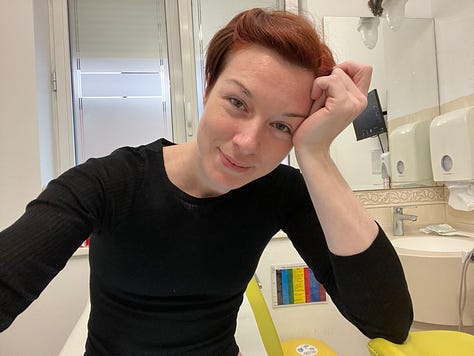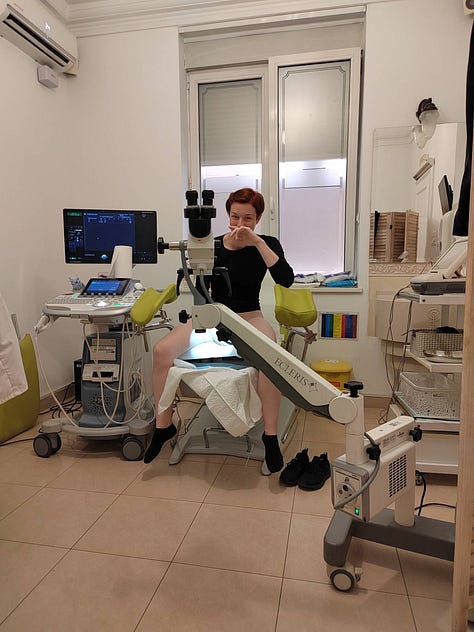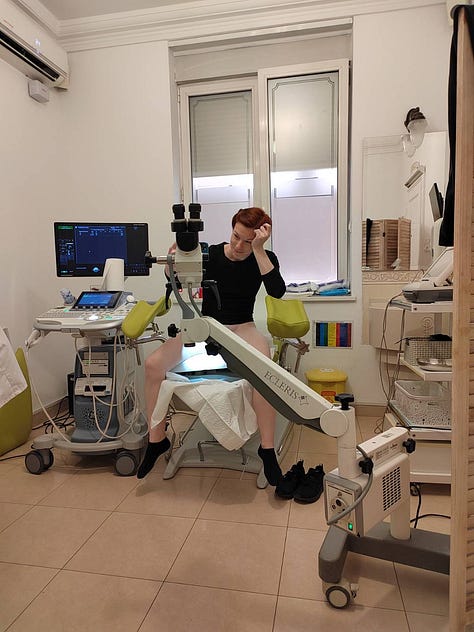If you ever followed me on Twitter, you’ve probably seen me discussing my menstrual cycle. I usually get some amount of flak when I talk about this online. This flak comes from dudes—dudely dudes who I suspect are uncomfortable with the reminder that we’re all mammals. The same types who leave barfing faces under Instagram photos when I have armpit hair. I also tend to receive several other types of reactions, ranging from sympathy, through empathy, to commiseration. That last category of feedback, though—people who deal with the same sorts of issues—they express gratitude for my raising awareness, and occasionally have a helpful tip. They’re the reason I keep discussing this stuff.
My first period was purplish brown sludge. It hurt, like there was a bottle brush up in my lower abdomen and a giant hand was squeezing me from the outside like a tube of toothpaste. I didn’t get another one for a few months. This was deemed, and probably was, normal.
My next period was bright red. It was a kind of pain that pointe shoes and dance injuries didn’t even come close to. I knew, from reading book after book written by feminists about women’s bodies, that exercise was supposed to help. I tried Midol, Tylenol, Aspirin. Only Aleve put a dent in the pain, and only halfway. I pushed through it and exercised anyway. This was also probably normal.
My periods never became regular. Gynecologists told me it would get better as I got older. They suggested hormonal birth control pills. They told me all the benefits. It would regulate my cycle. It would prevent acne (which I didn’t have). It would prevent pregnancy but I still needed to use condoms to prevent sexually transmittable infections. They said I might “spot”—a little bit of blood here and there—as my body adapted.
I took the pills. After the first three weeks of pills with active ingredients, I took the placebo pills that keep you in the habit of taking the pill every day. I bled. I finished the placebos and went back to the active ones. I didn’t stop bleeding. The world began to smell funny. Awful, really. My skin itched like when I had PMS — but all the time. I felt immense sadness and incredible rage. They insisted it would get better as my body adjusted. I threw a shoe at someone. Eventually I stopped taking the pills. Everything went back to normal-for-me.
By my mid-twenties I’d tried several different kinds of oral hormones. It was the same every time. Three weeks of slowly becoming more emotional and more reactive, my senses going screwy. Then the spotting that was more like full menstrual flow on a medium day. The “spotting” continued as the emotional and sensory side effects increased. I started going woozy when I stood, or sometimes even when I sat.
———
I was also growing cysts whether I was on the birth control pills or not. Every once in a while I’d burst one. I’d report to a gynecologist in excruciating pain. I’d be sent for an ultrasound, which would confirm the remains of the cyst’s sack and the fluid nearby. Sometimes health insurance would cover these tests, and sometimes it wouldn’t. I declined work in porn because I didn’t know whether I would make it through a sex scene. I started asking doctors whether I had Polycystic Ovary Syndrome. Whether I could be evaluated for PCOS, please—I was happy to pay out of pocket. At least two different gynecologists denied me that screening and said I couldn’t possibly have PCOS because I was thin and beardless.
I tried one last form of oral hormone, this time armed with a Diva Cup. This particular brand of menstrual cup has quarter ounce measurements. When the latest gynecologist questioned whether there was really that much blood I told her precisely how much. She questioned how I knew. I reached between my legs, yanked out my half full cup, and asked her to look at the measurement marks. She asked me to put it away, without seeming to engage with the device.
I grew cysts every cycle, alternating ovaries depending on which one was releasing an egg that time. One time the cyst was bigger than a large chicken egg. The gynecologist told me the only thing she could think of was surgery to drain the cysts. She added, though, that they would probably continue to grow. Surgery every cycle wasn’t an option. She joked that we could put a zipper in. Desperate and credulous, I asked what kind of follow-up care that would require. I often had menstrual cramps from halfway down my thighs up to my solar plexus. When it got to the point where I couldn’t be sitting upright or standing without alcohol to dull the abdominal pain, I tried to jump off a roof into a canyon. I quit taking the hormone pills. Everything went back to normal-for-me.
I lost hope in the US medical system. I went to one last gyno, recommended by my psychiatrist at the time, who diagnosed me with clinical premenstrual syndrome. I didn’t even bother to ask about PCOS, my irregular cycles, the heavy bleeding. The referring psychiatrist also diagnosed me with premenstrual dysphoric disorder. I resigned myself to irregular cycles, bouts of insanity before bleeding, and periods so heavy I couldn’t be without a bathroom for more than 90 minutes.
———
Shortly before I moved to Serbia a few Belgrade locals all recommended the same endocrinologist. They swore she’d helped their sisters, friends, girlfriends with issues just like mine. I made an appointment. My best friend hopefully suggested that maybe a different country would have a different perspective. When I walked into her office she asked where my gynecologist’s report was and where my hormone and blood sugar tests were. I told her a brief synopsis of my story, ending with “I’m done screwing around. You’re supposed to be the best in the country. So I came straight to you. Which gynecologist do you recommend?”
The exact doctor she recommended couldn’t see me at first so I saw a man at the same office. He asked why I was there. I answered “several reasons, the most pressing of which is that I’m on day 8 of my period.” He asked a few questions about my cycle and then when I was diagnosed with polycystic ovarian syndrome. I exclaimed “I was told by at least two doctors in the US that I couldn’t possibly have that.”
He had me hop up on the table for an ultrasound. He showed me my ovaries—full of cysts, as usual. He requested I get hormone tests done on the second day of my next period and a glucose processing screening sometime in the next few weeks. I saw the gyno who had been initially recommended. To her, my particular cystic ovaries didn’t look like PCOS ovaries, but my hormones were indeed different from what one would expect and my blood glucose tests were concerning.
The endocrinologist made the official diagnosis—PCOS. She told me to take several supplements, including myo-inositol, and to avoid sugar. My periods became regular. Every three weeks. So I had about one week of relative peace, about one week of hormone induced insanity, and 5-9 days of menstruating.
I was grateful to be in a country where the medical system took me seriously. I was frustrated that it had taken this long—24 years since the onset of menses. I ranted about how perhaps the US doctors who wanted me out of porn so badly would have been successful if they’d fixed the physical issue that made me fairly unemployable in other fields—not that I’d minded my chosen profession more than anyone else seemed to mind their own.
I went to a nutritionist for instruction in how to maintain my weight while avoiding sugar. She gave me a diet with practically zero fat. I went to a second. She seemed more reasonable. I followed her instructions and got so thin that Instagram followers started to comment fearing for my health. It was a mess. I rely on social media, which is almost entirely visual, to drive traffic to the work I get paid for. The algorithm prefers near—but not actual—nudity. So there I was, half naked in Internet-public, mostly bones, begging everyone I know who writes about bodies to direct me to a piece of writing that might explain my situation for me. No such piece of writing was found.
Take a minute to consider how utterly unrelatable “I’m struggling to keep weight on despite eating more than advised four times a day” is. Eventually a friend who trained as a doctor informed me that nutritionists aren’t doctors. She told me to eat what a granny would eat. I told her Vera mostly ate Swanson TV dinners and Peggy cooked green things in lard until they were grey. She told me to eat what a sane granny would eat. I threw the nutritionist’s plans and recipes away. I started to look healthy again.
I was still woozy and lethargic. The endocrinologist declared my iron was still too low, despite the pills. I wondered whether menstruating every three weeks had anything to do with that. One morning I sat down to video chat with Mitcz. I had just put on an overnight-level-absorption pair of period panties. Two hours later I’d soaked through them and ruined the pillow I was sitting on. I went to yet another gynecologist (we’ll call them Serbian Gyno #3) because they were local and could see me that day. Serbian Gyno #3 asked me how much blood. I told him what had happened, emphasizing that that’s twice as much as usual. He said my usual was still too much bleeding and recommended… hormones.
I told him my saga with oral hormonal birth control. I asked if there was a way to look at my exact hormone profile and make an educated guess on which pill might work. He informed me that isn’t possible and suggested the Mirena IUD. US doctors had made the same recommendation, but it hit differently when it was coming from a doctor who treated me like a human. He confidently told me that the hormones would balance the reproductive system issues without affecting me systemically. He insisted that the hormones would be localized.
The endocrinologist agreed. My psychiatrist here concurred. And Serbian Gyno #4 agreed. Every woman I know with similar menstrual issues implored me not to do this, saying it would drive me nuts. Two thirds of the women I talked with told me their own horror story or a tale of how their cousin’s baby came out holding the coil. I felt like I was out of reasonable options. All the doctors said it wouldn’t hurt at all. All the civilian women said it would hurt like hell.
———
The likely last day of my most recent period, I went into Serbian Gyno #4’s office. Lydia—my kuma, which is a form of chosen family—came with me. Serbian Gyno #4 agreed to let me make an audio recording of the process.
The first Mirena was faulty. It hurt like severe cramps but not the extra severe ones that make me vomit. It felt like something was wrong.
It was removed. The pain stopped. While we waited for a new one, I took a selfie. Lydia took a picture of me taking the selfie. I saw her taking pictures and she took a picture of that moment.



I suggested we try again on my next cycle. Serbian Gyno #4 reminded me it was my choice but she recommended we go ahead with the second Mirena that day. Lydia agreed with SG#4. I knew that Lydia knew if I left that day there was a good chance I’d never see a gynecologist again.
Imagine.
“When was your last pap smear?”
“2022.”
“But it’s 2038. You’re nearly in menopause”
“I know, robodoc, I know.”
The second Mirena went in exactly as it should. There was a little pinch. Then nothing other than the knowledge that I had a foreign object in my body and a whole bunch of adrenaline still surging from the first attempt.
I did a little dance while I waited for my paperwork. I continued to dance as the payment system communicated with my bank. I suggested a celebratory rakija.
“Ziveli!”
(We lived!)
And the clink of glasses.
I had lived, through everything that led up to the moment where the IUD settled inside of me, including the initial botch. I was living. I would continue to live. A few hours later, the NSAID I’d taken, the adrenaline, and the rakija had all worn off. I continued to live, but with cramping.
———
The endocrinologist, the two most recent gynecologists, my psychiatrist, my kuma, my spiritual mentor, and one lover with a higher than average understanding of hormones and access to google all say it’s going to take time for my body to adjust to both the foreign object and the hormonal shifts.
Three days in, I cramp only when I walk or am jostled vigorously, such as in a taxi with a driver who shifts gears harshly. I have spent more time crying today than not. The world smells funny. Things taste different. I am itchy all over. I’ve marked my calendar for six months from the date of insertion—the absolute biggest window of time I’ve been told it might take for my body to adjust—and will try to keep my mind off of it.
I won’t be visiting anywhere with canyons.
I will try not to throw shoes.
A purplish brown sludge gathers on my panties.
———
28 days after the insertion, I’ve had my period for nine days.
Red blood, steadily flowing.
Only five months and two days before I can evaluate whether this has worked.



